Visitor Attraction Management Report - Business Development Module
VerifiedAdded on 2020/07/22
|13
|4731
|50
Report
AI Summary
This report provides a comprehensive analysis of visitor attraction management, focusing on the UK context. It begins by examining the overlapping of different visitor attractions and their relative importance. The report then delves into the needs and motivations of various visitor types, exploring the impacts of tourism on attractions, and analyzing how different theories of tourist motivation influence management strategies. Furthermore, it covers different visitor management strategies and evaluates management techniques in relation to sustainability. The research also provides insights into the role of Visit Britain and the broader implications for business development within the tourism sector. The report emphasizes the importance of balancing economic growth with the preservation of attractions and the satisfaction of visitors.

VISITORS ATTRACTION
MANAGEMENT
MANAGEMENT
Paraphrase This Document
Need a fresh take? Get an instant paraphrase of this document with our AI Paraphraser
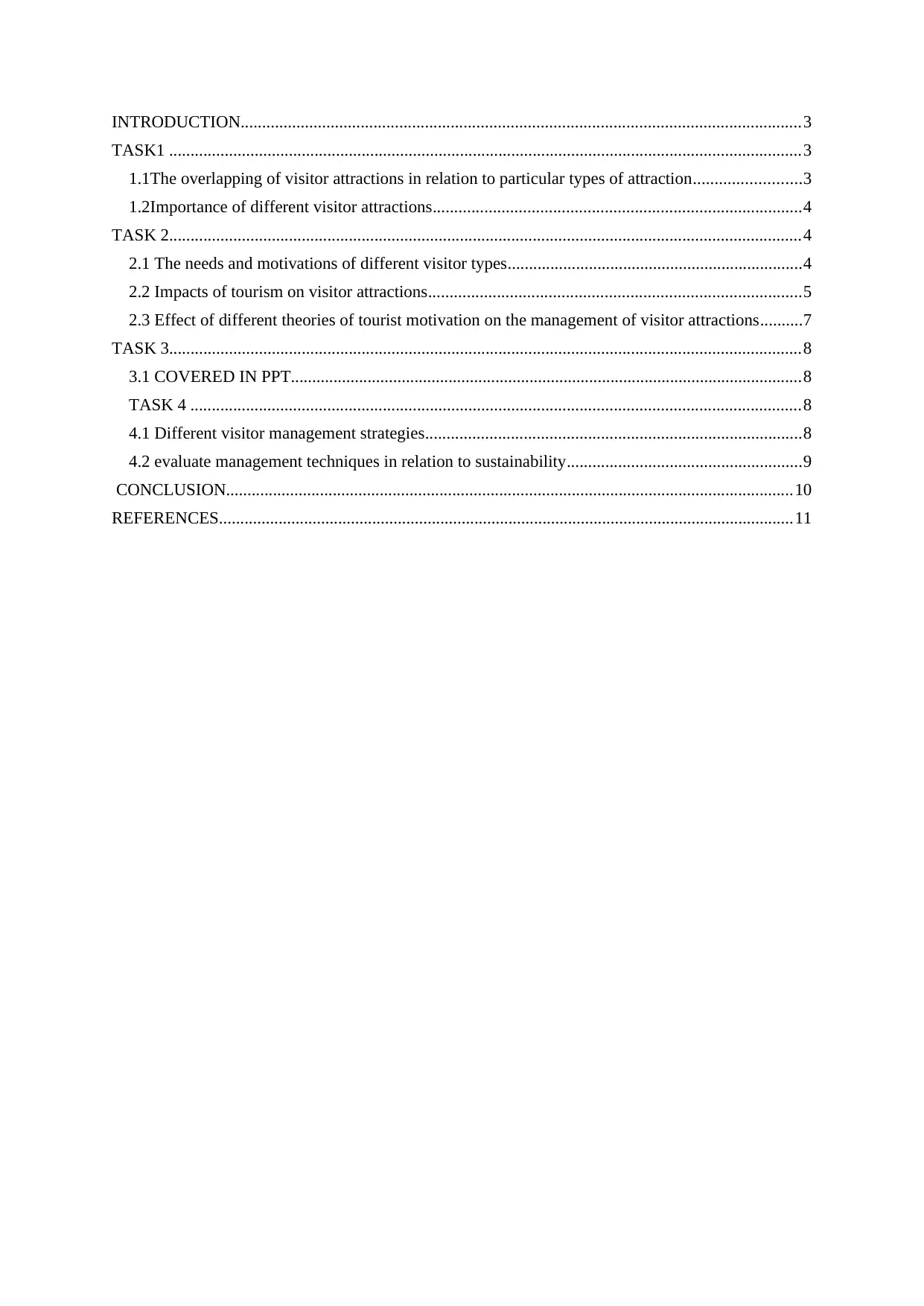
INTRODUCTION...................................................................................................................................3
TASK1 ....................................................................................................................................................3
1.1The overlapping of visitor attractions in relation to particular types of attraction.........................3
1.2Importance of different visitor attractions......................................................................................4
TASK 2....................................................................................................................................................4
2.1 The needs and motivations of different visitor types.....................................................................4
2.2 Impacts of tourism on visitor attractions.......................................................................................5
2.3 Effect of different theories of tourist motivation on the management of visitor attractions..........7
TASK 3....................................................................................................................................................8
3.1 COVERED IN PPT........................................................................................................................8
TASK 4 ...............................................................................................................................................8
4.1 Different visitor management strategies........................................................................................8
4.2 evaluate management techniques in relation to sustainability.......................................................9
CONCLUSION.....................................................................................................................................10
REFERENCES.......................................................................................................................................11
TASK1 ....................................................................................................................................................3
1.1The overlapping of visitor attractions in relation to particular types of attraction.........................3
1.2Importance of different visitor attractions......................................................................................4
TASK 2....................................................................................................................................................4
2.1 The needs and motivations of different visitor types.....................................................................4
2.2 Impacts of tourism on visitor attractions.......................................................................................5
2.3 Effect of different theories of tourist motivation on the management of visitor attractions..........7
TASK 3....................................................................................................................................................8
3.1 COVERED IN PPT........................................................................................................................8
TASK 4 ...............................................................................................................................................8
4.1 Different visitor management strategies........................................................................................8
4.2 evaluate management techniques in relation to sustainability.......................................................9
CONCLUSION.....................................................................................................................................10
REFERENCES.......................................................................................................................................11
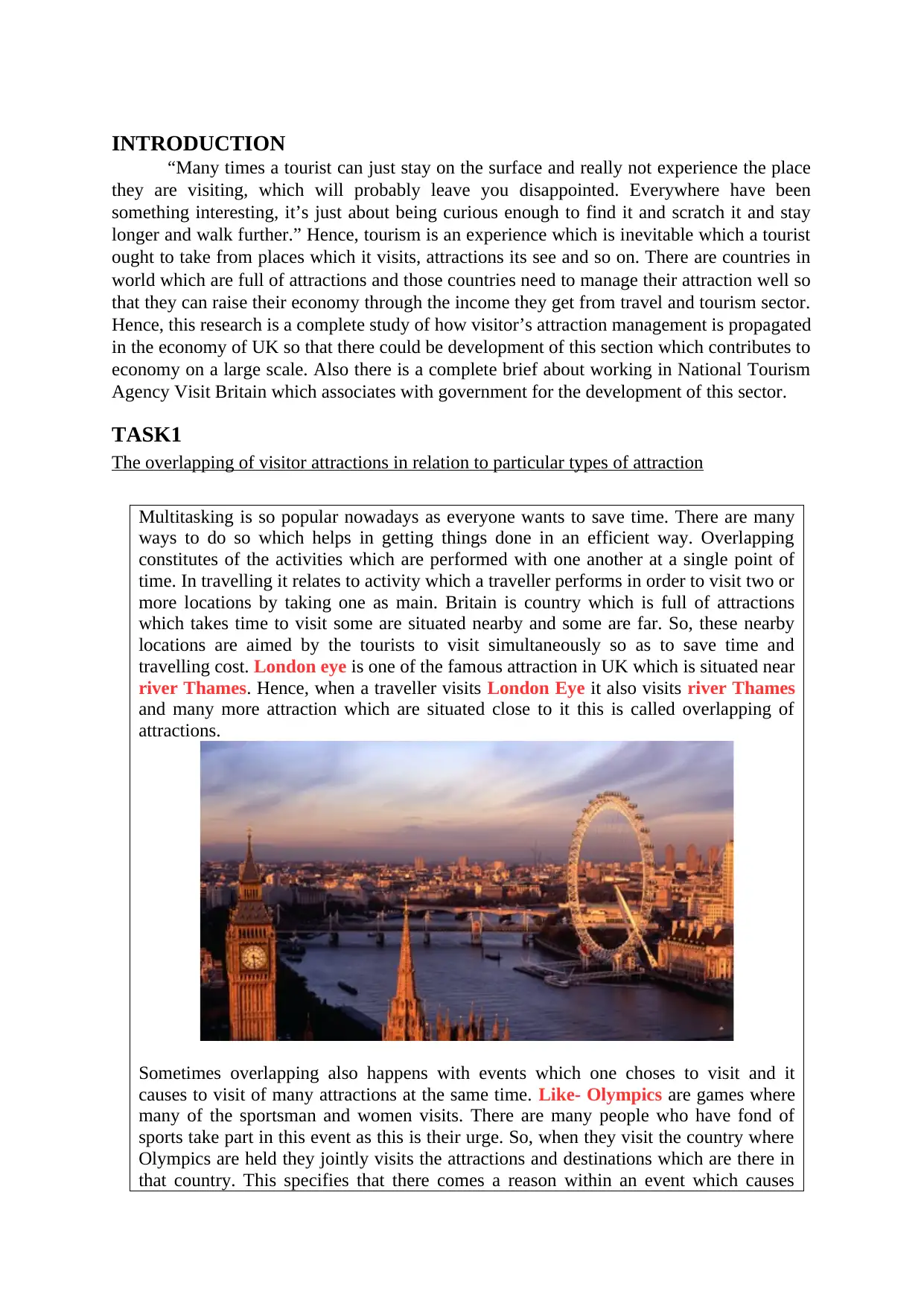
INTRODUCTION
“Many times a tourist can just stay on the surface and really not experience the place
they are visiting, which will probably leave you disappointed. Everywhere have been
something interesting, it’s just about being curious enough to find it and scratch it and stay
longer and walk further.” Hence, tourism is an experience which is inevitable which a tourist
ought to take from places which it visits, attractions its see and so on. There are countries in
world which are full of attractions and those countries need to manage their attraction well so
that they can raise their economy through the income they get from travel and tourism sector.
Hence, this research is a complete study of how visitor’s attraction management is propagated
in the economy of UK so that there could be development of this section which contributes to
economy on a large scale. Also there is a complete brief about working in National Tourism
Agency Visit Britain which associates with government for the development of this sector.
TASK1
The overlapping of visitor attractions in relation to particular types of attraction
Multitasking is so popular nowadays as everyone wants to save time. There are many
ways to do so which helps in getting things done in an efficient way. Overlapping
constitutes of the activities which are performed with one another at a single point of
time. In travelling it relates to activity which a traveller performs in order to visit two or
more locations by taking one as main. Britain is country which is full of attractions
which takes time to visit some are situated nearby and some are far. So, these nearby
locations are aimed by the tourists to visit simultaneously so as to save time and
travelling cost. London eye is one of the famous attraction in UK which is situated near
river Thames. Hence, when a traveller visits London Eye it also visits river Thames
and many more attraction which are situated close to it this is called overlapping of
attractions.
Sometimes overlapping also happens with events which one choses to visit and it
causes to visit of many attractions at the same time. Like- Olympics are games where
many of the sportsman and women visits. There are many people who have fond of
sports take part in this event as this is their urge. So, when they visit the country where
Olympics are held they jointly visits the attractions and destinations which are there in
that country. This specifies that there comes a reason within an event which causes
“Many times a tourist can just stay on the surface and really not experience the place
they are visiting, which will probably leave you disappointed. Everywhere have been
something interesting, it’s just about being curious enough to find it and scratch it and stay
longer and walk further.” Hence, tourism is an experience which is inevitable which a tourist
ought to take from places which it visits, attractions its see and so on. There are countries in
world which are full of attractions and those countries need to manage their attraction well so
that they can raise their economy through the income they get from travel and tourism sector.
Hence, this research is a complete study of how visitor’s attraction management is propagated
in the economy of UK so that there could be development of this section which contributes to
economy on a large scale. Also there is a complete brief about working in National Tourism
Agency Visit Britain which associates with government for the development of this sector.
TASK1
The overlapping of visitor attractions in relation to particular types of attraction
Multitasking is so popular nowadays as everyone wants to save time. There are many
ways to do so which helps in getting things done in an efficient way. Overlapping
constitutes of the activities which are performed with one another at a single point of
time. In travelling it relates to activity which a traveller performs in order to visit two or
more locations by taking one as main. Britain is country which is full of attractions
which takes time to visit some are situated nearby and some are far. So, these nearby
locations are aimed by the tourists to visit simultaneously so as to save time and
travelling cost. London eye is one of the famous attraction in UK which is situated near
river Thames. Hence, when a traveller visits London Eye it also visits river Thames
and many more attraction which are situated close to it this is called overlapping of
attractions.
Sometimes overlapping also happens with events which one choses to visit and it
causes to visit of many attractions at the same time. Like- Olympics are games where
many of the sportsman and women visits. There are many people who have fond of
sports take part in this event as this is their urge. So, when they visit the country where
Olympics are held they jointly visits the attractions and destinations which are there in
that country. This specifies that there comes a reason within an event which causes
⊘ This is a preview!⊘
Do you want full access?
Subscribe today to unlock all pages.

Trusted by 1+ million students worldwide
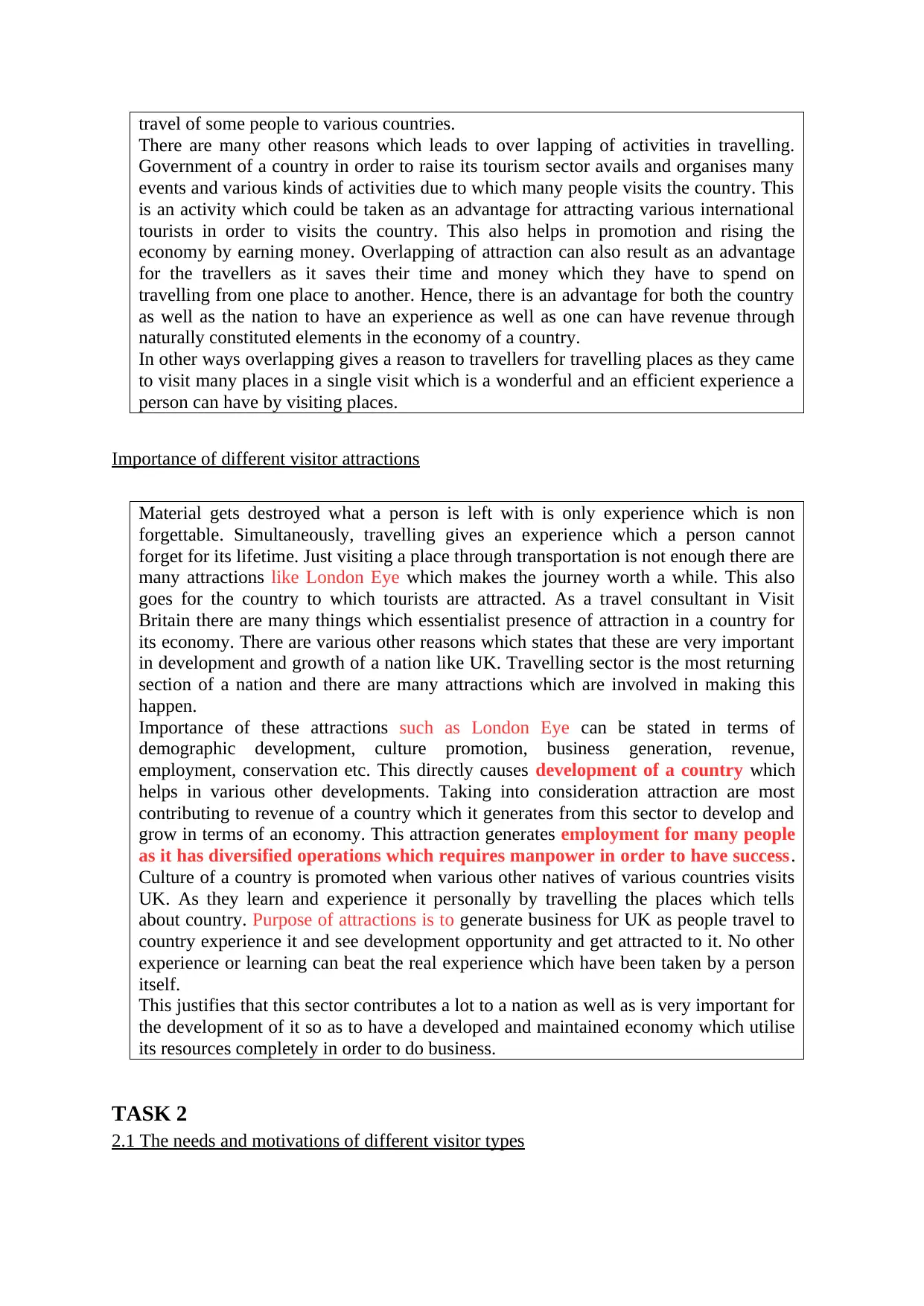
travel of some people to various countries.
There are many other reasons which leads to over lapping of activities in travelling.
Government of a country in order to raise its tourism sector avails and organises many
events and various kinds of activities due to which many people visits the country. This
is an activity which could be taken as an advantage for attracting various international
tourists in order to visits the country. This also helps in promotion and rising the
economy by earning money. Overlapping of attraction can also result as an advantage
for the travellers as it saves their time and money which they have to spend on
travelling from one place to another. Hence, there is an advantage for both the country
as well as the nation to have an experience as well as one can have revenue through
naturally constituted elements in the economy of a country.
In other ways overlapping gives a reason to travellers for travelling places as they came
to visit many places in a single visit which is a wonderful and an efficient experience a
person can have by visiting places.
Importance of different visitor attractions
Material gets destroyed what a person is left with is only experience which is non
forgettable. Simultaneously, travelling gives an experience which a person cannot
forget for its lifetime. Just visiting a place through transportation is not enough there are
many attractions like London Eye which makes the journey worth a while. This also
goes for the country to which tourists are attracted. As a travel consultant in Visit
Britain there are many things which essentialist presence of attraction in a country for
its economy. There are various other reasons which states that these are very important
in development and growth of a nation like UK. Travelling sector is the most returning
section of a nation and there are many attractions which are involved in making this
happen.
Importance of these attractions such as London Eye can be stated in terms of
demographic development, culture promotion, business generation, revenue,
employment, conservation etc. This directly causes development of a country which
helps in various other developments. Taking into consideration attraction are most
contributing to revenue of a country which it generates from this sector to develop and
grow in terms of an economy. This attraction generates employment for many people
as it has diversified operations which requires manpower in order to have success.
Culture of a country is promoted when various other natives of various countries visits
UK. As they learn and experience it personally by travelling the places which tells
about country. Purpose of attractions is to generate business for UK as people travel to
country experience it and see development opportunity and get attracted to it. No other
experience or learning can beat the real experience which have been taken by a person
itself.
This justifies that this sector contributes a lot to a nation as well as is very important for
the development of it so as to have a developed and maintained economy which utilise
its resources completely in order to do business.
TASK 2
2.1 The needs and motivations of different visitor types
There are many other reasons which leads to over lapping of activities in travelling.
Government of a country in order to raise its tourism sector avails and organises many
events and various kinds of activities due to which many people visits the country. This
is an activity which could be taken as an advantage for attracting various international
tourists in order to visits the country. This also helps in promotion and rising the
economy by earning money. Overlapping of attraction can also result as an advantage
for the travellers as it saves their time and money which they have to spend on
travelling from one place to another. Hence, there is an advantage for both the country
as well as the nation to have an experience as well as one can have revenue through
naturally constituted elements in the economy of a country.
In other ways overlapping gives a reason to travellers for travelling places as they came
to visit many places in a single visit which is a wonderful and an efficient experience a
person can have by visiting places.
Importance of different visitor attractions
Material gets destroyed what a person is left with is only experience which is non
forgettable. Simultaneously, travelling gives an experience which a person cannot
forget for its lifetime. Just visiting a place through transportation is not enough there are
many attractions like London Eye which makes the journey worth a while. This also
goes for the country to which tourists are attracted. As a travel consultant in Visit
Britain there are many things which essentialist presence of attraction in a country for
its economy. There are various other reasons which states that these are very important
in development and growth of a nation like UK. Travelling sector is the most returning
section of a nation and there are many attractions which are involved in making this
happen.
Importance of these attractions such as London Eye can be stated in terms of
demographic development, culture promotion, business generation, revenue,
employment, conservation etc. This directly causes development of a country which
helps in various other developments. Taking into consideration attraction are most
contributing to revenue of a country which it generates from this sector to develop and
grow in terms of an economy. This attraction generates employment for many people
as it has diversified operations which requires manpower in order to have success.
Culture of a country is promoted when various other natives of various countries visits
UK. As they learn and experience it personally by travelling the places which tells
about country. Purpose of attractions is to generate business for UK as people travel to
country experience it and see development opportunity and get attracted to it. No other
experience or learning can beat the real experience which have been taken by a person
itself.
This justifies that this sector contributes a lot to a nation as well as is very important for
the development of it so as to have a developed and maintained economy which utilise
its resources completely in order to do business.
TASK 2
2.1 The needs and motivations of different visitor types
Paraphrase This Document
Need a fresh take? Get an instant paraphrase of this document with our AI Paraphraser
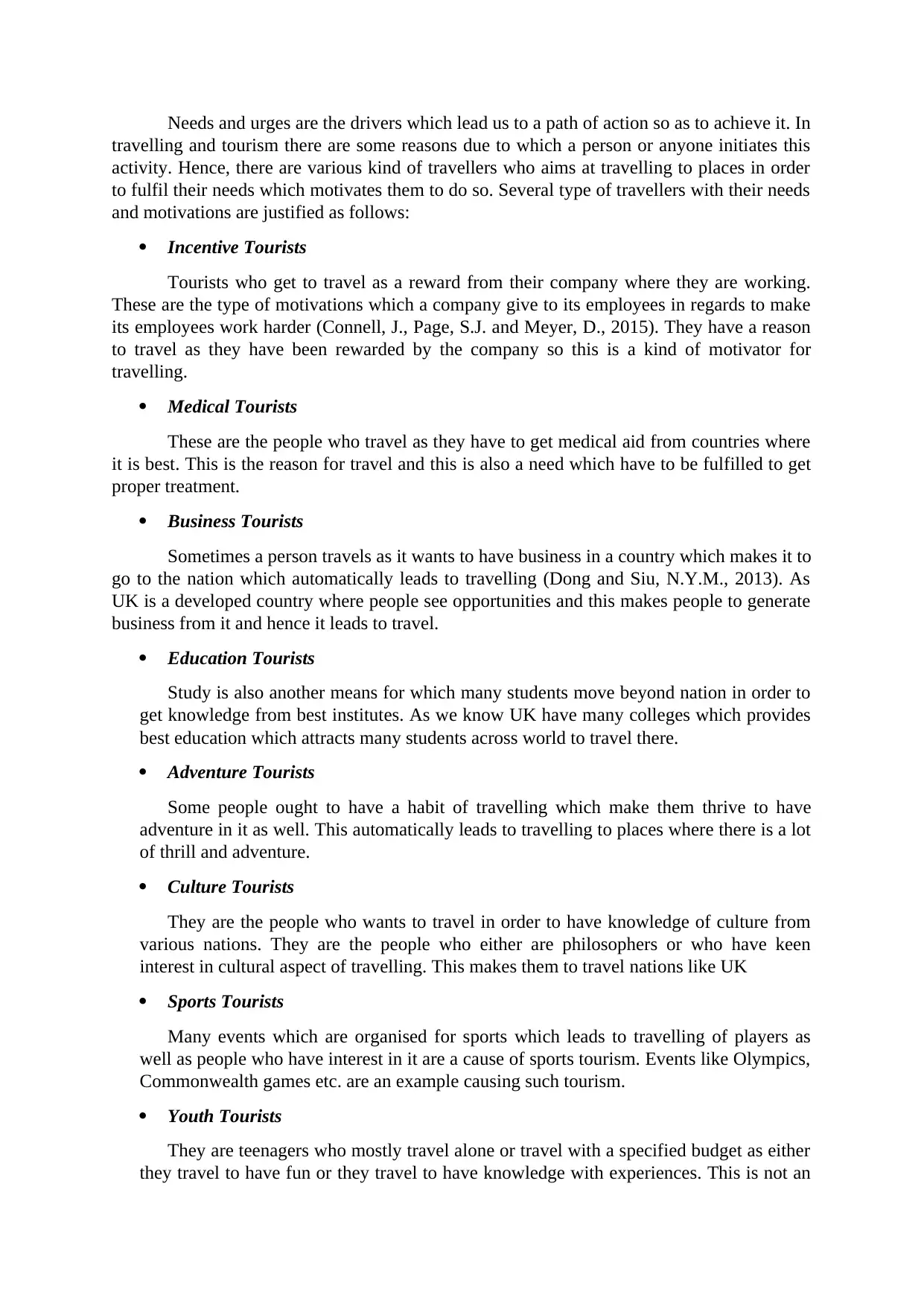
Needs and urges are the drivers which lead us to a path of action so as to achieve it. In
travelling and tourism there are some reasons due to which a person or anyone initiates this
activity. Hence, there are various kind of travellers who aims at travelling to places in order
to fulfil their needs which motivates them to do so. Several type of travellers with their needs
and motivations are justified as follows:
Incentive Tourists
Tourists who get to travel as a reward from their company where they are working.
These are the type of motivations which a company give to its employees in regards to make
its employees work harder (Connell, J., Page, S.J. and Meyer, D., 2015). They have a reason
to travel as they have been rewarded by the company so this is a kind of motivator for
travelling.
Medical Tourists
These are the people who travel as they have to get medical aid from countries where
it is best. This is the reason for travel and this is also a need which have to be fulfilled to get
proper treatment.
Business Tourists
Sometimes a person travels as it wants to have business in a country which makes it to
go to the nation which automatically leads to travelling (Dong and Siu, N.Y.M., 2013). As
UK is a developed country where people see opportunities and this makes people to generate
business from it and hence it leads to travel.
Education Tourists
Study is also another means for which many students move beyond nation in order to
get knowledge from best institutes. As we know UK have many colleges which provides
best education which attracts many students across world to travel there.
Adventure Tourists
Some people ought to have a habit of travelling which make them thrive to have
adventure in it as well. This automatically leads to travelling to places where there is a lot
of thrill and adventure.
Culture Tourists
They are the people who wants to travel in order to have knowledge of culture from
various nations. They are the people who either are philosophers or who have keen
interest in cultural aspect of travelling. This makes them to travel nations like UK
Sports Tourists
Many events which are organised for sports which leads to travelling of players as
well as people who have interest in it are a cause of sports tourism. Events like Olympics,
Commonwealth games etc. are an example causing such tourism.
Youth Tourists
They are teenagers who mostly travel alone or travel with a specified budget as either
they travel to have fun or they travel to have knowledge with experiences. This is not an
travelling and tourism there are some reasons due to which a person or anyone initiates this
activity. Hence, there are various kind of travellers who aims at travelling to places in order
to fulfil their needs which motivates them to do so. Several type of travellers with their needs
and motivations are justified as follows:
Incentive Tourists
Tourists who get to travel as a reward from their company where they are working.
These are the type of motivations which a company give to its employees in regards to make
its employees work harder (Connell, J., Page, S.J. and Meyer, D., 2015). They have a reason
to travel as they have been rewarded by the company so this is a kind of motivator for
travelling.
Medical Tourists
These are the people who travel as they have to get medical aid from countries where
it is best. This is the reason for travel and this is also a need which have to be fulfilled to get
proper treatment.
Business Tourists
Sometimes a person travels as it wants to have business in a country which makes it to
go to the nation which automatically leads to travelling (Dong and Siu, N.Y.M., 2013). As
UK is a developed country where people see opportunities and this makes people to generate
business from it and hence it leads to travel.
Education Tourists
Study is also another means for which many students move beyond nation in order to
get knowledge from best institutes. As we know UK have many colleges which provides
best education which attracts many students across world to travel there.
Adventure Tourists
Some people ought to have a habit of travelling which make them thrive to have
adventure in it as well. This automatically leads to travelling to places where there is a lot
of thrill and adventure.
Culture Tourists
They are the people who wants to travel in order to have knowledge of culture from
various nations. They are the people who either are philosophers or who have keen
interest in cultural aspect of travelling. This makes them to travel nations like UK
Sports Tourists
Many events which are organised for sports which leads to travelling of players as
well as people who have interest in it are a cause of sports tourism. Events like Olympics,
Commonwealth games etc. are an example causing such tourism.
Youth Tourists
They are teenagers who mostly travel alone or travel with a specified budget as either
they travel to have fun or they travel to have knowledge with experiences. This is not an
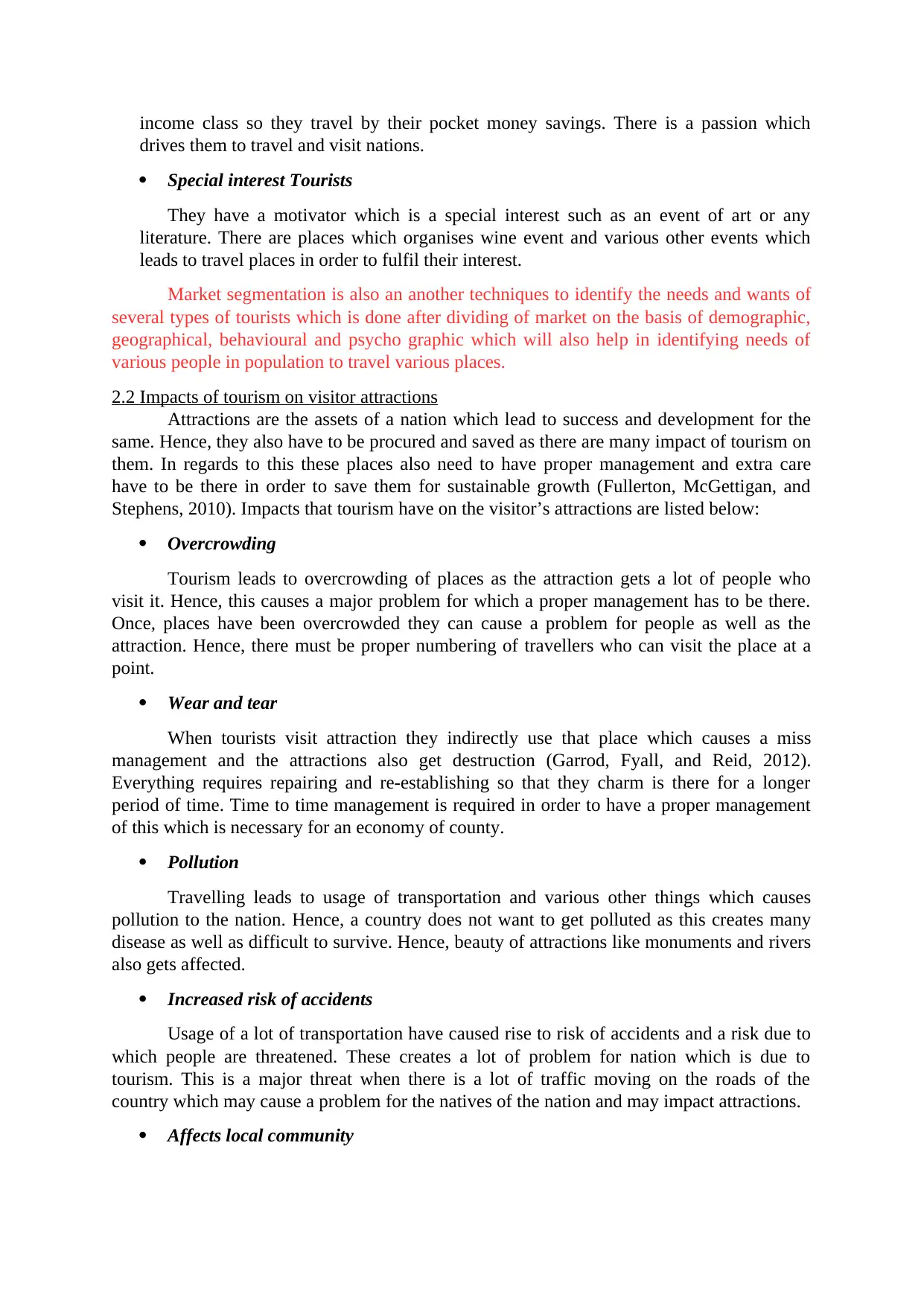
income class so they travel by their pocket money savings. There is a passion which
drives them to travel and visit nations.
Special interest Tourists
They have a motivator which is a special interest such as an event of art or any
literature. There are places which organises wine event and various other events which
leads to travel places in order to fulfil their interest.
Market segmentation is also an another techniques to identify the needs and wants of
several types of tourists which is done after dividing of market on the basis of demographic,
geographical, behavioural and psycho graphic which will also help in identifying needs of
various people in population to travel various places.
2.2 Impacts of tourism on visitor attractions
Attractions are the assets of a nation which lead to success and development for the
same. Hence, they also have to be procured and saved as there are many impact of tourism on
them. In regards to this these places also need to have proper management and extra care
have to be there in order to save them for sustainable growth (Fullerton, McGettigan, and
Stephens, 2010). Impacts that tourism have on the visitor’s attractions are listed below:
Overcrowding
Tourism leads to overcrowding of places as the attraction gets a lot of people who
visit it. Hence, this causes a major problem for which a proper management has to be there.
Once, places have been overcrowded they can cause a problem for people as well as the
attraction. Hence, there must be proper numbering of travellers who can visit the place at a
point.
Wear and tear
When tourists visit attraction they indirectly use that place which causes a miss
management and the attractions also get destruction (Garrod, Fyall, and Reid, 2012).
Everything requires repairing and re-establishing so that they charm is there for a longer
period of time. Time to time management is required in order to have a proper management
of this which is necessary for an economy of county.
Pollution
Travelling leads to usage of transportation and various other things which causes
pollution to the nation. Hence, a country does not want to get polluted as this creates many
disease as well as difficult to survive. Hence, beauty of attractions like monuments and rivers
also gets affected.
Increased risk of accidents
Usage of a lot of transportation have caused rise to risk of accidents and a risk due to
which people are threatened. These creates a lot of problem for nation which is due to
tourism. This is a major threat when there is a lot of traffic moving on the roads of the
country which may cause a problem for the natives of the nation and may impact attractions.
Affects local community
drives them to travel and visit nations.
Special interest Tourists
They have a motivator which is a special interest such as an event of art or any
literature. There are places which organises wine event and various other events which
leads to travel places in order to fulfil their interest.
Market segmentation is also an another techniques to identify the needs and wants of
several types of tourists which is done after dividing of market on the basis of demographic,
geographical, behavioural and psycho graphic which will also help in identifying needs of
various people in population to travel various places.
2.2 Impacts of tourism on visitor attractions
Attractions are the assets of a nation which lead to success and development for the
same. Hence, they also have to be procured and saved as there are many impact of tourism on
them. In regards to this these places also need to have proper management and extra care
have to be there in order to save them for sustainable growth (Fullerton, McGettigan, and
Stephens, 2010). Impacts that tourism have on the visitor’s attractions are listed below:
Overcrowding
Tourism leads to overcrowding of places as the attraction gets a lot of people who
visit it. Hence, this causes a major problem for which a proper management has to be there.
Once, places have been overcrowded they can cause a problem for people as well as the
attraction. Hence, there must be proper numbering of travellers who can visit the place at a
point.
Wear and tear
When tourists visit attraction they indirectly use that place which causes a miss
management and the attractions also get destruction (Garrod, Fyall, and Reid, 2012).
Everything requires repairing and re-establishing so that they charm is there for a longer
period of time. Time to time management is required in order to have a proper management
of this which is necessary for an economy of county.
Pollution
Travelling leads to usage of transportation and various other things which causes
pollution to the nation. Hence, a country does not want to get polluted as this creates many
disease as well as difficult to survive. Hence, beauty of attractions like monuments and rivers
also gets affected.
Increased risk of accidents
Usage of a lot of transportation have caused rise to risk of accidents and a risk due to
which people are threatened. These creates a lot of problem for nation which is due to
tourism. This is a major threat when there is a lot of traffic moving on the roads of the
country which may cause a problem for the natives of the nation and may impact attractions.
Affects local community
⊘ This is a preview!⊘
Do you want full access?
Subscribe today to unlock all pages.

Trusted by 1+ million students worldwide
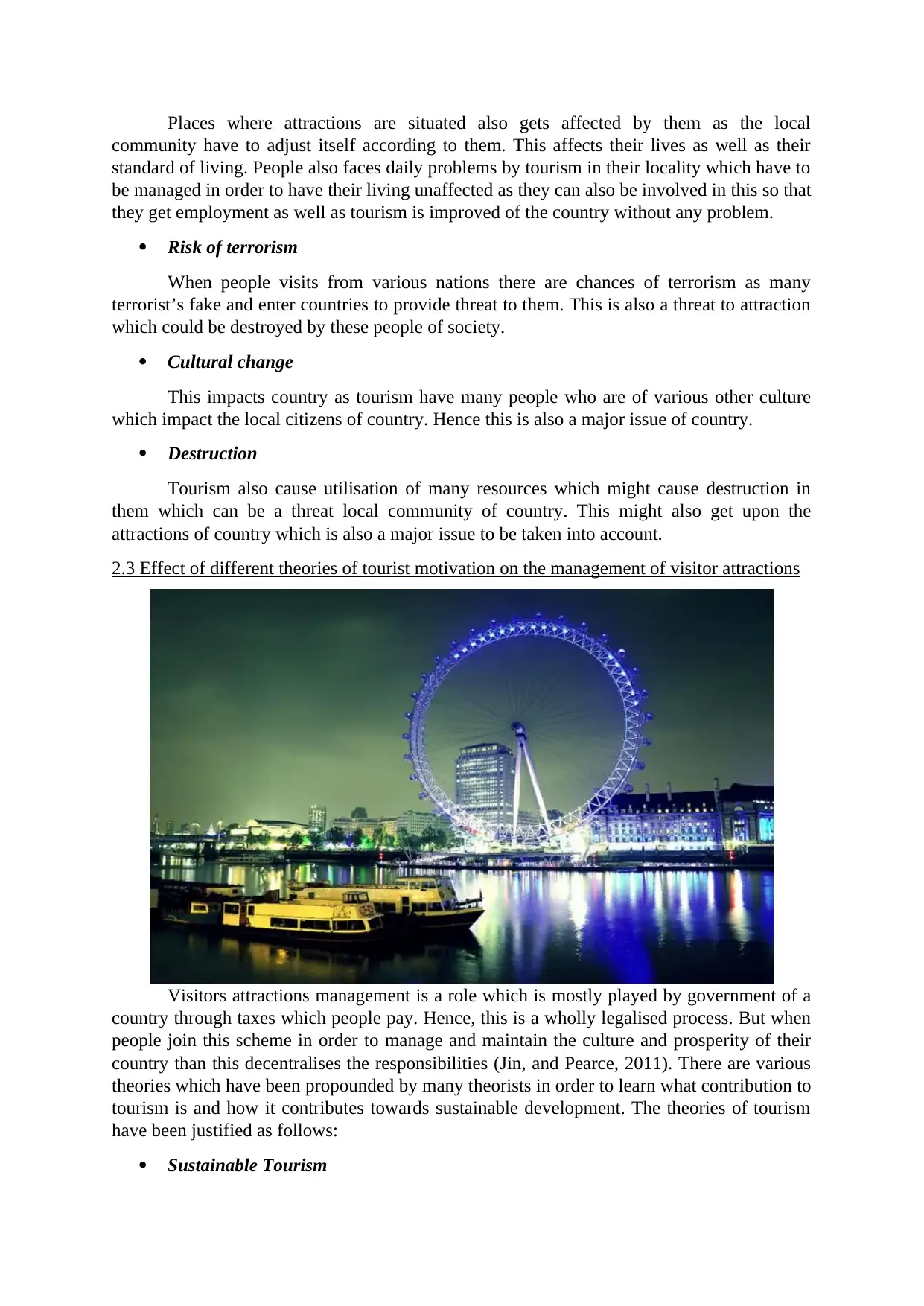
Places where attractions are situated also gets affected by them as the local
community have to adjust itself according to them. This affects their lives as well as their
standard of living. People also faces daily problems by tourism in their locality which have to
be managed in order to have their living unaffected as they can also be involved in this so that
they get employment as well as tourism is improved of the country without any problem.
Risk of terrorism
When people visits from various nations there are chances of terrorism as many
terrorist’s fake and enter countries to provide threat to them. This is also a threat to attraction
which could be destroyed by these people of society.
Cultural change
This impacts country as tourism have many people who are of various other culture
which impact the local citizens of country. Hence this is also a major issue of country.
Destruction
Tourism also cause utilisation of many resources which might cause destruction in
them which can be a threat local community of country. This might also get upon the
attractions of country which is also a major issue to be taken into account.
2.3 Effect of different theories of tourist motivation on the management of visitor attractions
Visitors attractions management is a role which is mostly played by government of a
country through taxes which people pay. Hence, this is a wholly legalised process. But when
people join this scheme in order to manage and maintain the culture and prosperity of their
country than this decentralises the responsibilities (Jin, and Pearce, 2011). There are various
theories which have been propounded by many theorists in order to learn what contribution to
tourism is and how it contributes towards sustainable development. The theories of tourism
have been justified as follows:
Sustainable Tourism
community have to adjust itself according to them. This affects their lives as well as their
standard of living. People also faces daily problems by tourism in their locality which have to
be managed in order to have their living unaffected as they can also be involved in this so that
they get employment as well as tourism is improved of the country without any problem.
Risk of terrorism
When people visits from various nations there are chances of terrorism as many
terrorist’s fake and enter countries to provide threat to them. This is also a threat to attraction
which could be destroyed by these people of society.
Cultural change
This impacts country as tourism have many people who are of various other culture
which impact the local citizens of country. Hence this is also a major issue of country.
Destruction
Tourism also cause utilisation of many resources which might cause destruction in
them which can be a threat local community of country. This might also get upon the
attractions of country which is also a major issue to be taken into account.
2.3 Effect of different theories of tourist motivation on the management of visitor attractions
Visitors attractions management is a role which is mostly played by government of a
country through taxes which people pay. Hence, this is a wholly legalised process. But when
people join this scheme in order to manage and maintain the culture and prosperity of their
country than this decentralises the responsibilities (Jin, and Pearce, 2011). There are various
theories which have been propounded by many theorists in order to learn what contribution to
tourism is and how it contributes towards sustainable development. The theories of tourism
have been justified as follows:
Sustainable Tourism
Paraphrase This Document
Need a fresh take? Get an instant paraphrase of this document with our AI Paraphraser
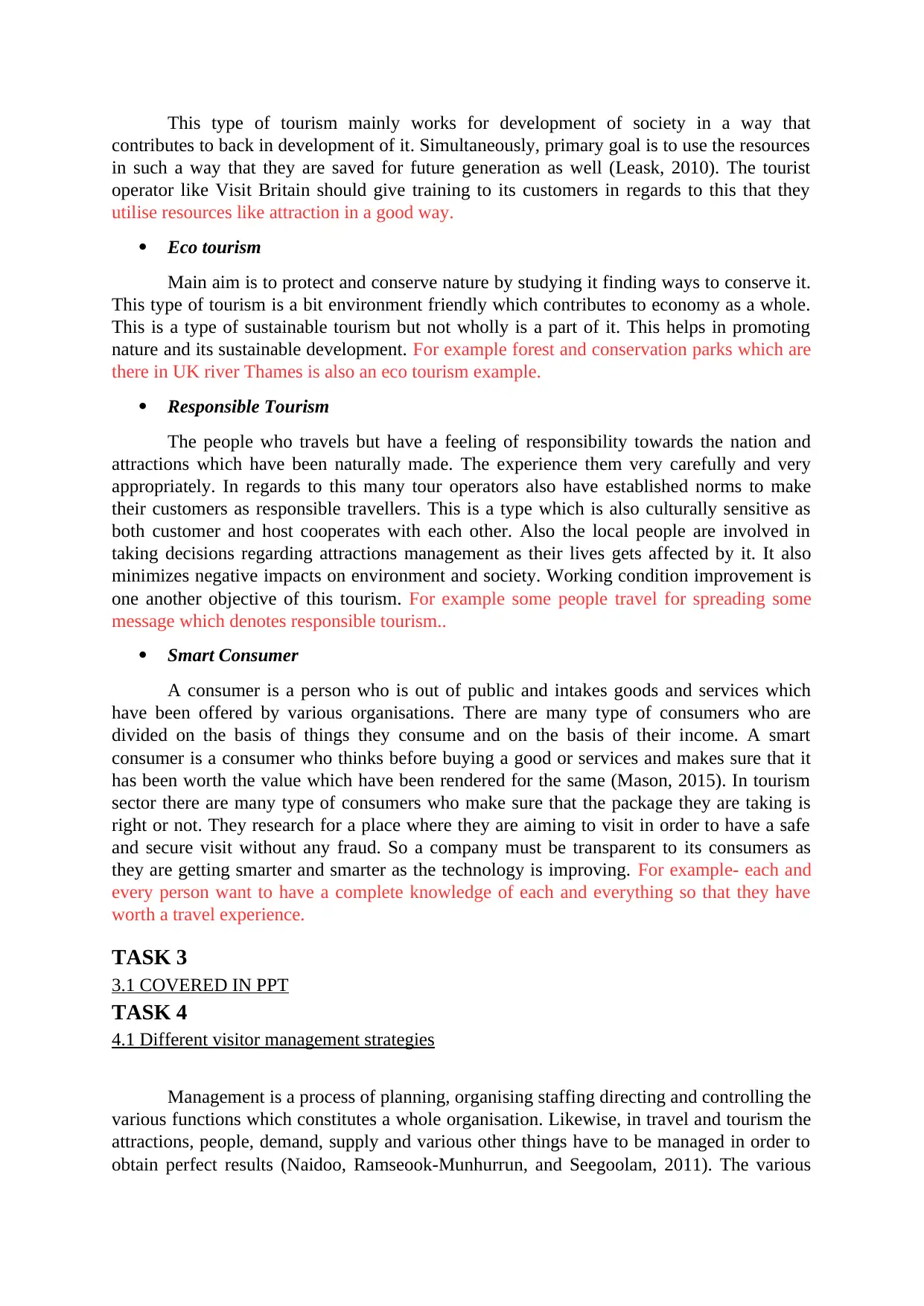
This type of tourism mainly works for development of society in a way that
contributes to back in development of it. Simultaneously, primary goal is to use the resources
in such a way that they are saved for future generation as well (Leask, 2010). The tourist
operator like Visit Britain should give training to its customers in regards to this that they
utilise resources like attraction in a good way.
Eco tourism
Main aim is to protect and conserve nature by studying it finding ways to conserve it.
This type of tourism is a bit environment friendly which contributes to economy as a whole.
This is a type of sustainable tourism but not wholly is a part of it. This helps in promoting
nature and its sustainable development. For example forest and conservation parks which are
there in UK river Thames is also an eco tourism example.
Responsible Tourism
The people who travels but have a feeling of responsibility towards the nation and
attractions which have been naturally made. The experience them very carefully and very
appropriately. In regards to this many tour operators also have established norms to make
their customers as responsible travellers. This is a type which is also culturally sensitive as
both customer and host cooperates with each other. Also the local people are involved in
taking decisions regarding attractions management as their lives gets affected by it. It also
minimizes negative impacts on environment and society. Working condition improvement is
one another objective of this tourism. For example some people travel for spreading some
message which denotes responsible tourism..
Smart Consumer
A consumer is a person who is out of public and intakes goods and services which
have been offered by various organisations. There are many type of consumers who are
divided on the basis of things they consume and on the basis of their income. A smart
consumer is a consumer who thinks before buying a good or services and makes sure that it
has been worth the value which have been rendered for the same (Mason, 2015). In tourism
sector there are many type of consumers who make sure that the package they are taking is
right or not. They research for a place where they are aiming to visit in order to have a safe
and secure visit without any fraud. So a company must be transparent to its consumers as
they are getting smarter and smarter as the technology is improving. For example- each and
every person want to have a complete knowledge of each and everything so that they have
worth a travel experience.
TASK 3
3.1 COVERED IN PPT
TASK 4
4.1 Different visitor management strategies
Management is a process of planning, organising staffing directing and controlling the
various functions which constitutes a whole organisation. Likewise, in travel and tourism the
attractions, people, demand, supply and various other things have to be managed in order to
obtain perfect results (Naidoo, Ramseook-Munhurrun, and Seegoolam, 2011). The various
contributes to back in development of it. Simultaneously, primary goal is to use the resources
in such a way that they are saved for future generation as well (Leask, 2010). The tourist
operator like Visit Britain should give training to its customers in regards to this that they
utilise resources like attraction in a good way.
Eco tourism
Main aim is to protect and conserve nature by studying it finding ways to conserve it.
This type of tourism is a bit environment friendly which contributes to economy as a whole.
This is a type of sustainable tourism but not wholly is a part of it. This helps in promoting
nature and its sustainable development. For example forest and conservation parks which are
there in UK river Thames is also an eco tourism example.
Responsible Tourism
The people who travels but have a feeling of responsibility towards the nation and
attractions which have been naturally made. The experience them very carefully and very
appropriately. In regards to this many tour operators also have established norms to make
their customers as responsible travellers. This is a type which is also culturally sensitive as
both customer and host cooperates with each other. Also the local people are involved in
taking decisions regarding attractions management as their lives gets affected by it. It also
minimizes negative impacts on environment and society. Working condition improvement is
one another objective of this tourism. For example some people travel for spreading some
message which denotes responsible tourism..
Smart Consumer
A consumer is a person who is out of public and intakes goods and services which
have been offered by various organisations. There are many type of consumers who are
divided on the basis of things they consume and on the basis of their income. A smart
consumer is a consumer who thinks before buying a good or services and makes sure that it
has been worth the value which have been rendered for the same (Mason, 2015). In tourism
sector there are many type of consumers who make sure that the package they are taking is
right or not. They research for a place where they are aiming to visit in order to have a safe
and secure visit without any fraud. So a company must be transparent to its consumers as
they are getting smarter and smarter as the technology is improving. For example- each and
every person want to have a complete knowledge of each and everything so that they have
worth a travel experience.
TASK 3
3.1 COVERED IN PPT
TASK 4
4.1 Different visitor management strategies
Management is a process of planning, organising staffing directing and controlling the
various functions which constitutes a whole organisation. Likewise, in travel and tourism the
attractions, people, demand, supply and various other things have to be managed in order to
obtain perfect results (Naidoo, Ramseook-Munhurrun, and Seegoolam, 2011). The various
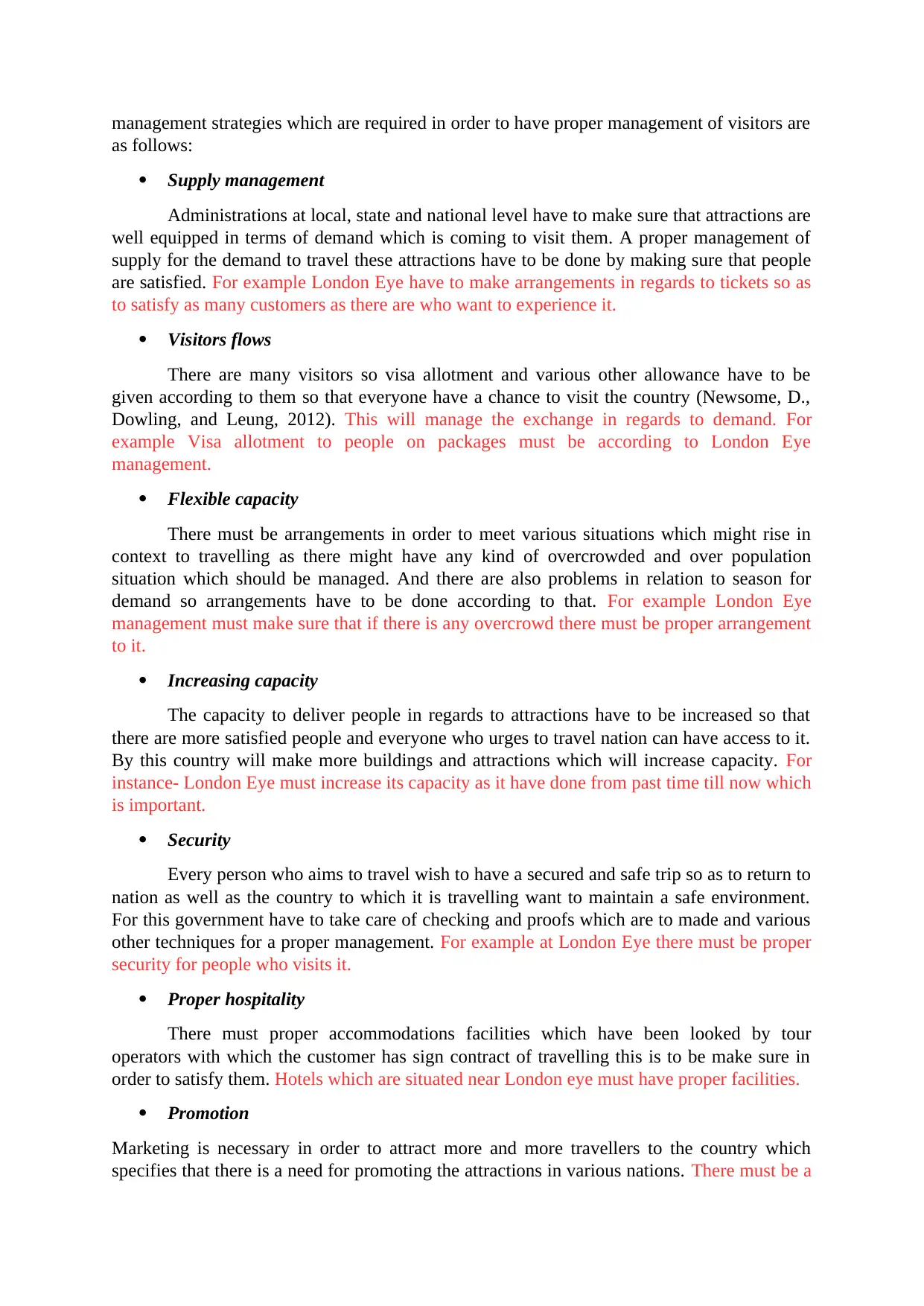
management strategies which are required in order to have proper management of visitors are
as follows:
Supply management
Administrations at local, state and national level have to make sure that attractions are
well equipped in terms of demand which is coming to visit them. A proper management of
supply for the demand to travel these attractions have to be done by making sure that people
are satisfied. For example London Eye have to make arrangements in regards to tickets so as
to satisfy as many customers as there are who want to experience it.
Visitors flows
There are many visitors so visa allotment and various other allowance have to be
given according to them so that everyone have a chance to visit the country (Newsome, D.,
Dowling, and Leung, 2012). This will manage the exchange in regards to demand. For
example Visa allotment to people on packages must be according to London Eye
management.
Flexible capacity
There must be arrangements in order to meet various situations which might rise in
context to travelling as there might have any kind of overcrowded and over population
situation which should be managed. And there are also problems in relation to season for
demand so arrangements have to be done according to that. For example London Eye
management must make sure that if there is any overcrowd there must be proper arrangement
to it.
Increasing capacity
The capacity to deliver people in regards to attractions have to be increased so that
there are more satisfied people and everyone who urges to travel nation can have access to it.
By this country will make more buildings and attractions which will increase capacity. For
instance- London Eye must increase its capacity as it have done from past time till now which
is important.
Security
Every person who aims to travel wish to have a secured and safe trip so as to return to
nation as well as the country to which it is travelling want to maintain a safe environment.
For this government have to take care of checking and proofs which are to made and various
other techniques for a proper management. For example at London Eye there must be proper
security for people who visits it.
Proper hospitality
There must proper accommodations facilities which have been looked by tour
operators with which the customer has sign contract of travelling this is to be make sure in
order to satisfy them. Hotels which are situated near London eye must have proper facilities.
Promotion
Marketing is necessary in order to attract more and more travellers to the country which
specifies that there is a need for promoting the attractions in various nations. There must be a
as follows:
Supply management
Administrations at local, state and national level have to make sure that attractions are
well equipped in terms of demand which is coming to visit them. A proper management of
supply for the demand to travel these attractions have to be done by making sure that people
are satisfied. For example London Eye have to make arrangements in regards to tickets so as
to satisfy as many customers as there are who want to experience it.
Visitors flows
There are many visitors so visa allotment and various other allowance have to be
given according to them so that everyone have a chance to visit the country (Newsome, D.,
Dowling, and Leung, 2012). This will manage the exchange in regards to demand. For
example Visa allotment to people on packages must be according to London Eye
management.
Flexible capacity
There must be arrangements in order to meet various situations which might rise in
context to travelling as there might have any kind of overcrowded and over population
situation which should be managed. And there are also problems in relation to season for
demand so arrangements have to be done according to that. For example London Eye
management must make sure that if there is any overcrowd there must be proper arrangement
to it.
Increasing capacity
The capacity to deliver people in regards to attractions have to be increased so that
there are more satisfied people and everyone who urges to travel nation can have access to it.
By this country will make more buildings and attractions which will increase capacity. For
instance- London Eye must increase its capacity as it have done from past time till now which
is important.
Security
Every person who aims to travel wish to have a secured and safe trip so as to return to
nation as well as the country to which it is travelling want to maintain a safe environment.
For this government have to take care of checking and proofs which are to made and various
other techniques for a proper management. For example at London Eye there must be proper
security for people who visits it.
Proper hospitality
There must proper accommodations facilities which have been looked by tour
operators with which the customer has sign contract of travelling this is to be make sure in
order to satisfy them. Hotels which are situated near London eye must have proper facilities.
Promotion
Marketing is necessary in order to attract more and more travellers to the country which
specifies that there is a need for promoting the attractions in various nations. There must be a
⊘ This is a preview!⊘
Do you want full access?
Subscribe today to unlock all pages.

Trusted by 1+ million students worldwide
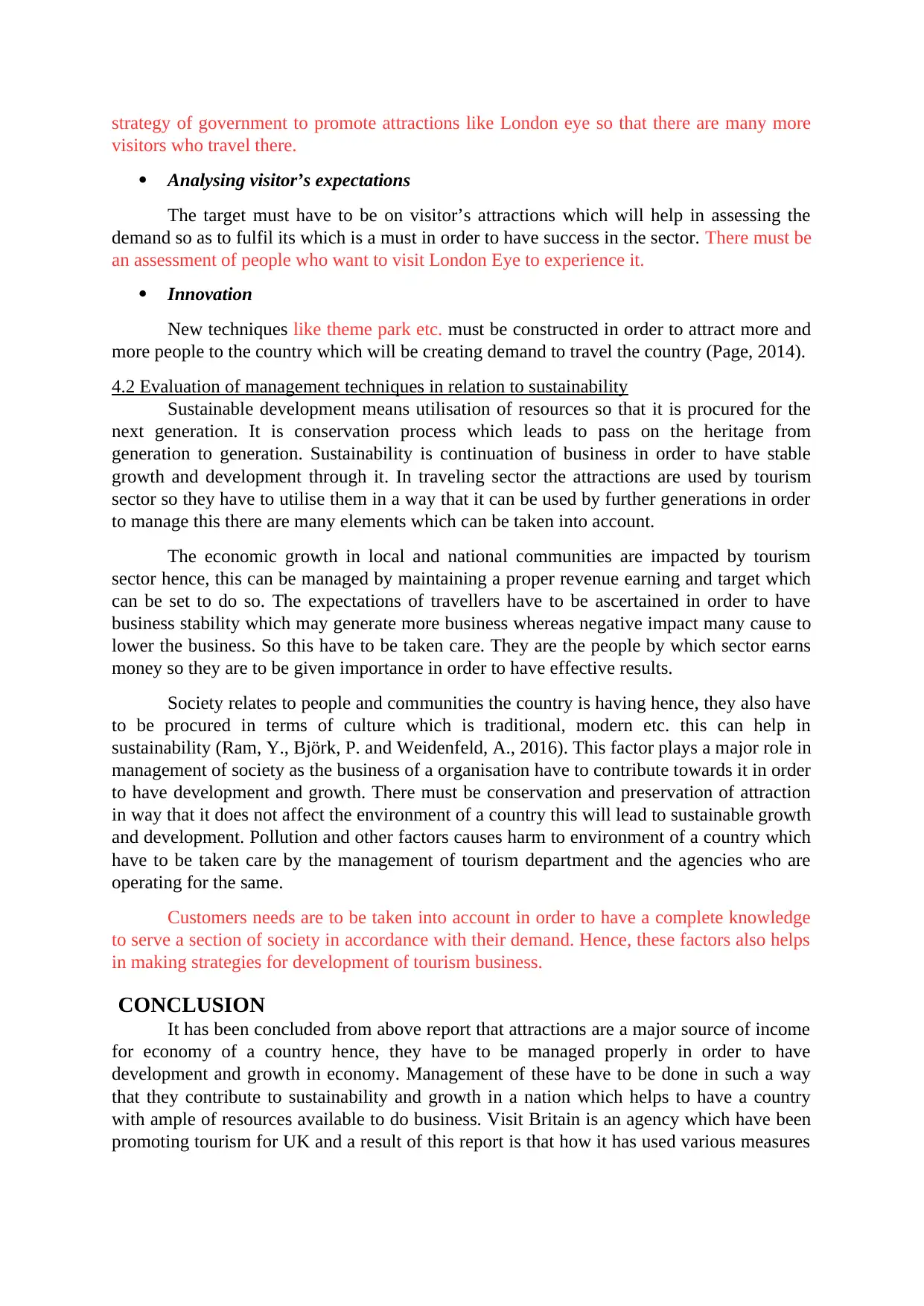
strategy of government to promote attractions like London eye so that there are many more
visitors who travel there.
Analysing visitor’s expectations
The target must have to be on visitor’s attractions which will help in assessing the
demand so as to fulfil its which is a must in order to have success in the sector. There must be
an assessment of people who want to visit London Eye to experience it.
Innovation
New techniques like theme park etc. must be constructed in order to attract more and
more people to the country which will be creating demand to travel the country (Page, 2014).
4.2 Evaluation of management techniques in relation to sustainability
Sustainable development means utilisation of resources so that it is procured for the
next generation. It is conservation process which leads to pass on the heritage from
generation to generation. Sustainability is continuation of business in order to have stable
growth and development through it. In traveling sector the attractions are used by tourism
sector so they have to utilise them in a way that it can be used by further generations in order
to manage this there are many elements which can be taken into account.
The economic growth in local and national communities are impacted by tourism
sector hence, this can be managed by maintaining a proper revenue earning and target which
can be set to do so. The expectations of travellers have to be ascertained in order to have
business stability which may generate more business whereas negative impact many cause to
lower the business. So this have to be taken care. They are the people by which sector earns
money so they are to be given importance in order to have effective results.
Society relates to people and communities the country is having hence, they also have
to be procured in terms of culture which is traditional, modern etc. this can help in
sustainability (Ram, Y., Björk, P. and Weidenfeld, A., 2016). This factor plays a major role in
management of society as the business of a organisation have to contribute towards it in order
to have development and growth. There must be conservation and preservation of attraction
in way that it does not affect the environment of a country this will lead to sustainable growth
and development. Pollution and other factors causes harm to environment of a country which
have to be taken care by the management of tourism department and the agencies who are
operating for the same.
Customers needs are to be taken into account in order to have a complete knowledge
to serve a section of society in accordance with their demand. Hence, these factors also helps
in making strategies for development of tourism business.
CONCLUSION
It has been concluded from above report that attractions are a major source of income
for economy of a country hence, they have to be managed properly in order to have
development and growth in economy. Management of these have to be done in such a way
that they contribute to sustainability and growth in a nation which helps to have a country
with ample of resources available to do business. Visit Britain is an agency which have been
promoting tourism for UK and a result of this report is that how it has used various measures
visitors who travel there.
Analysing visitor’s expectations
The target must have to be on visitor’s attractions which will help in assessing the
demand so as to fulfil its which is a must in order to have success in the sector. There must be
an assessment of people who want to visit London Eye to experience it.
Innovation
New techniques like theme park etc. must be constructed in order to attract more and
more people to the country which will be creating demand to travel the country (Page, 2014).
4.2 Evaluation of management techniques in relation to sustainability
Sustainable development means utilisation of resources so that it is procured for the
next generation. It is conservation process which leads to pass on the heritage from
generation to generation. Sustainability is continuation of business in order to have stable
growth and development through it. In traveling sector the attractions are used by tourism
sector so they have to utilise them in a way that it can be used by further generations in order
to manage this there are many elements which can be taken into account.
The economic growth in local and national communities are impacted by tourism
sector hence, this can be managed by maintaining a proper revenue earning and target which
can be set to do so. The expectations of travellers have to be ascertained in order to have
business stability which may generate more business whereas negative impact many cause to
lower the business. So this have to be taken care. They are the people by which sector earns
money so they are to be given importance in order to have effective results.
Society relates to people and communities the country is having hence, they also have
to be procured in terms of culture which is traditional, modern etc. this can help in
sustainability (Ram, Y., Björk, P. and Weidenfeld, A., 2016). This factor plays a major role in
management of society as the business of a organisation have to contribute towards it in order
to have development and growth. There must be conservation and preservation of attraction
in way that it does not affect the environment of a country this will lead to sustainable growth
and development. Pollution and other factors causes harm to environment of a country which
have to be taken care by the management of tourism department and the agencies who are
operating for the same.
Customers needs are to be taken into account in order to have a complete knowledge
to serve a section of society in accordance with their demand. Hence, these factors also helps
in making strategies for development of tourism business.
CONCLUSION
It has been concluded from above report that attractions are a major source of income
for economy of a country hence, they have to be managed properly in order to have
development and growth in economy. Management of these have to be done in such a way
that they contribute to sustainability and growth in a nation which helps to have a country
with ample of resources available to do business. Visit Britain is an agency which have been
promoting tourism for UK and a result of this report is that how it has used various measures
Paraphrase This Document
Need a fresh take? Get an instant paraphrase of this document with our AI Paraphraser

in order to have a safer and secured tourism business in the country. It has also been obtained
that this sectors contributes to the economy of UK in a very huge number.
that this sectors contributes to the economy of UK in a very huge number.
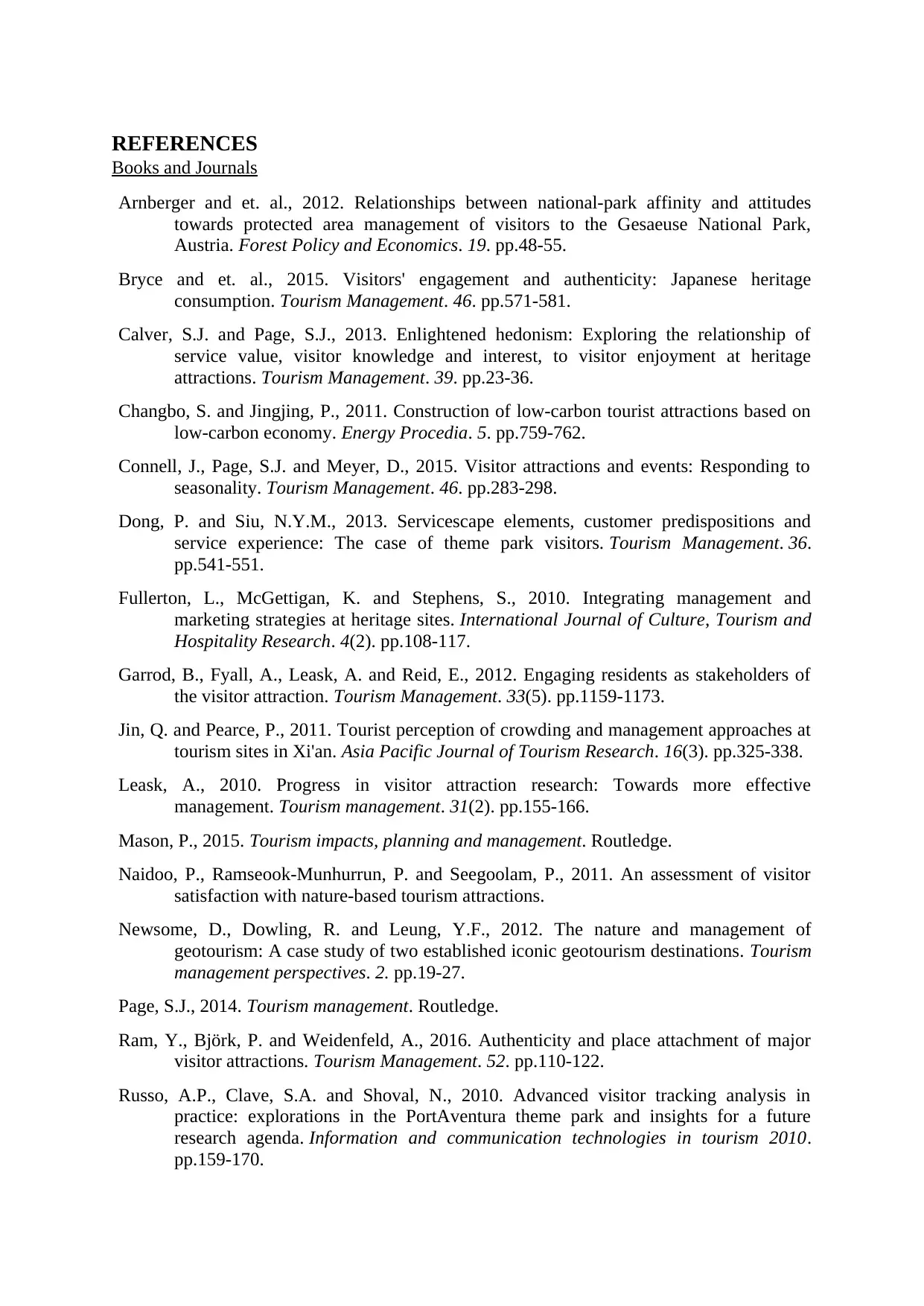
REFERENCES
Books and Journals
Arnberger and et. al., 2012. Relationships between national-park affinity and attitudes
towards protected area management of visitors to the Gesaeuse National Park,
Austria. Forest Policy and Economics. 19. pp.48-55.
Bryce and et. al., 2015. Visitors' engagement and authenticity: Japanese heritage
consumption. Tourism Management. 46. pp.571-581.
Calver, S.J. and Page, S.J., 2013. Enlightened hedonism: Exploring the relationship of
service value, visitor knowledge and interest, to visitor enjoyment at heritage
attractions. Tourism Management. 39. pp.23-36.
Changbo, S. and Jingjing, P., 2011. Construction of low-carbon tourist attractions based on
low-carbon economy. Energy Procedia. 5. pp.759-762.
Connell, J., Page, S.J. and Meyer, D., 2015. Visitor attractions and events: Responding to
seasonality. Tourism Management. 46. pp.283-298.
Dong, P. and Siu, N.Y.M., 2013. Servicescape elements, customer predispositions and
service experience: The case of theme park visitors. Tourism Management. 36.
pp.541-551.
Fullerton, L., McGettigan, K. and Stephens, S., 2010. Integrating management and
marketing strategies at heritage sites. International Journal of Culture, Tourism and
Hospitality Research. 4(2). pp.108-117.
Garrod, B., Fyall, A., Leask, A. and Reid, E., 2012. Engaging residents as stakeholders of
the visitor attraction. Tourism Management. 33(5). pp.1159-1173.
Jin, Q. and Pearce, P., 2011. Tourist perception of crowding and management approaches at
tourism sites in Xi'an. Asia Pacific Journal of Tourism Research. 16(3). pp.325-338.
Leask, A., 2010. Progress in visitor attraction research: Towards more effective
management. Tourism management. 31(2). pp.155-166.
Mason, P., 2015. Tourism impacts, planning and management. Routledge.
Naidoo, P., Ramseook-Munhurrun, P. and Seegoolam, P., 2011. An assessment of visitor
satisfaction with nature-based tourism attractions.
Newsome, D., Dowling, R. and Leung, Y.F., 2012. The nature and management of
geotourism: A case study of two established iconic geotourism destinations. Tourism
management perspectives. 2. pp.19-27.
Page, S.J., 2014. Tourism management. Routledge.
Ram, Y., Björk, P. and Weidenfeld, A., 2016. Authenticity and place attachment of major
visitor attractions. Tourism Management. 52. pp.110-122.
Russo, A.P., Clave, S.A. and Shoval, N., 2010. Advanced visitor tracking analysis in
practice: explorations in the PortAventura theme park and insights for a future
research agenda. Information and communication technologies in tourism 2010.
pp.159-170.
Books and Journals
Arnberger and et. al., 2012. Relationships between national-park affinity and attitudes
towards protected area management of visitors to the Gesaeuse National Park,
Austria. Forest Policy and Economics. 19. pp.48-55.
Bryce and et. al., 2015. Visitors' engagement and authenticity: Japanese heritage
consumption. Tourism Management. 46. pp.571-581.
Calver, S.J. and Page, S.J., 2013. Enlightened hedonism: Exploring the relationship of
service value, visitor knowledge and interest, to visitor enjoyment at heritage
attractions. Tourism Management. 39. pp.23-36.
Changbo, S. and Jingjing, P., 2011. Construction of low-carbon tourist attractions based on
low-carbon economy. Energy Procedia. 5. pp.759-762.
Connell, J., Page, S.J. and Meyer, D., 2015. Visitor attractions and events: Responding to
seasonality. Tourism Management. 46. pp.283-298.
Dong, P. and Siu, N.Y.M., 2013. Servicescape elements, customer predispositions and
service experience: The case of theme park visitors. Tourism Management. 36.
pp.541-551.
Fullerton, L., McGettigan, K. and Stephens, S., 2010. Integrating management and
marketing strategies at heritage sites. International Journal of Culture, Tourism and
Hospitality Research. 4(2). pp.108-117.
Garrod, B., Fyall, A., Leask, A. and Reid, E., 2012. Engaging residents as stakeholders of
the visitor attraction. Tourism Management. 33(5). pp.1159-1173.
Jin, Q. and Pearce, P., 2011. Tourist perception of crowding and management approaches at
tourism sites in Xi'an. Asia Pacific Journal of Tourism Research. 16(3). pp.325-338.
Leask, A., 2010. Progress in visitor attraction research: Towards more effective
management. Tourism management. 31(2). pp.155-166.
Mason, P., 2015. Tourism impacts, planning and management. Routledge.
Naidoo, P., Ramseook-Munhurrun, P. and Seegoolam, P., 2011. An assessment of visitor
satisfaction with nature-based tourism attractions.
Newsome, D., Dowling, R. and Leung, Y.F., 2012. The nature and management of
geotourism: A case study of two established iconic geotourism destinations. Tourism
management perspectives. 2. pp.19-27.
Page, S.J., 2014. Tourism management. Routledge.
Ram, Y., Björk, P. and Weidenfeld, A., 2016. Authenticity and place attachment of major
visitor attractions. Tourism Management. 52. pp.110-122.
Russo, A.P., Clave, S.A. and Shoval, N., 2010. Advanced visitor tracking analysis in
practice: explorations in the PortAventura theme park and insights for a future
research agenda. Information and communication technologies in tourism 2010.
pp.159-170.
⊘ This is a preview!⊘
Do you want full access?
Subscribe today to unlock all pages.

Trusted by 1+ million students worldwide
1 out of 13
Related Documents
Your All-in-One AI-Powered Toolkit for Academic Success.
+13062052269
info@desklib.com
Available 24*7 on WhatsApp / Email
![[object Object]](/_next/static/media/star-bottom.7253800d.svg)
Unlock your academic potential
Copyright © 2020–2025 A2Z Services. All Rights Reserved. Developed and managed by ZUCOL.





